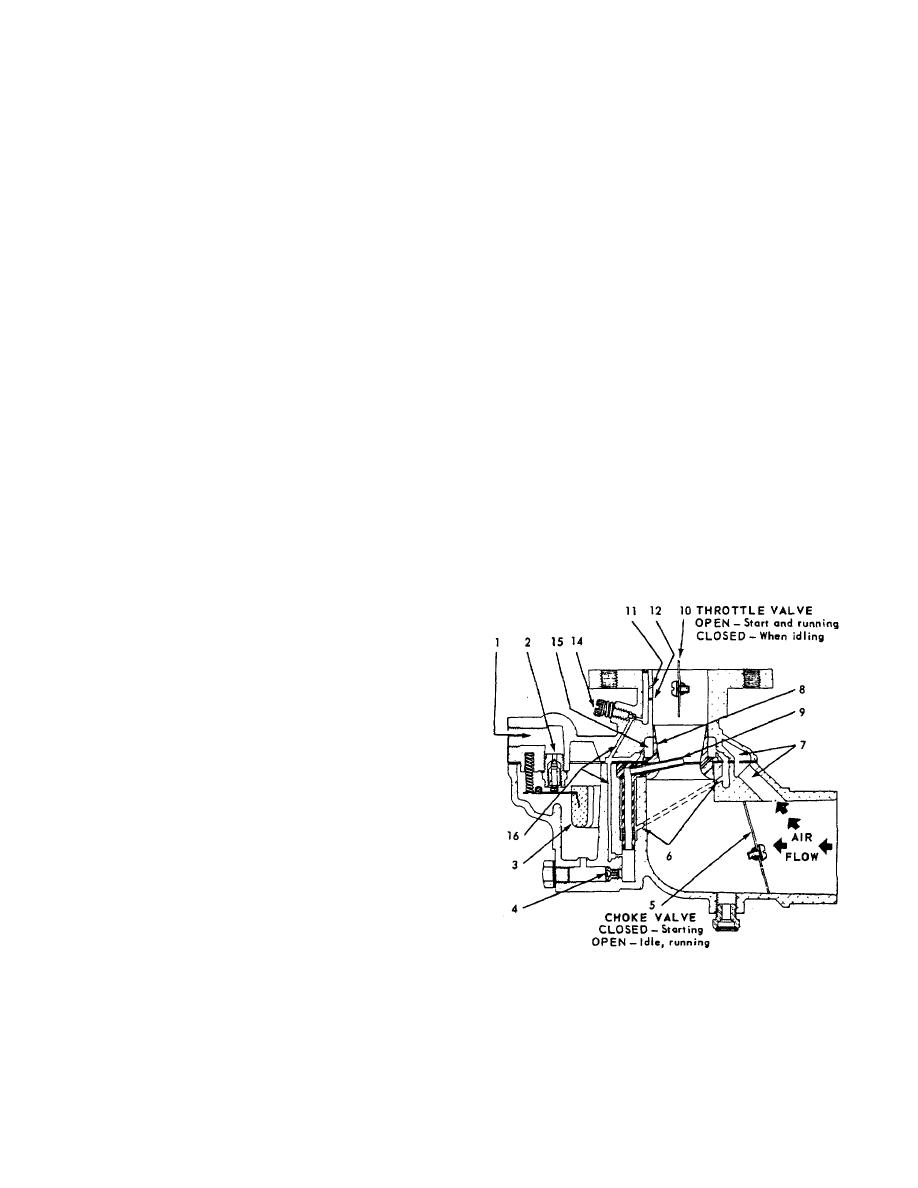
TM 5-3895-359-14&P
Nozzle (9) begins to satisfy this requirement beyond
and no load speeds of the engine and the hole
the idle hole and part throttle hole capacities.
corresponding thereto. Note that the full load speed is
less than the no load speed and this must be taken into
After the acceleration assist from the idle system; at full
consideration when readjusting the governor. The pump
throttle the complete idle circuit is reversed, as air only, in
engine operates at a full load speed of 2500 R.P.M. and
place of the fuel/air mixture, is drawn through the Idle
a no load speed of 2650 R.P.M. The spring should be
holes (11), (12), and Channel (16), to Nozzle (9), where it
hooked in hole 10 of the governor lever and the spring
is blended with fuel drawn from float chamber thru Jet (4).
tension adjusted by means of the adjusting screw to run
2650 R.P.M. at no load. When load is applied the
TROUBLE CAUSES AND REMEDIES Dirt is the major
engine will run at approximately 2500 R.P.M.
cause of field service carburetor problems.
A tachometer or revolution counter should be used
An adequate Fuel Filter must be used between the tank
against the crankshaft to check speed while adjusting
and carburetor, and should be serviced frequently. Service
the governor spring tension. Tightening the adjusting
Air Filter daily Keep carburetor and linkage free of dirt.
screw locknut will give higher speeds, while loosening
the locknut will lower the spring tension and reduce the
FUEL LEAKS FROM CARBURETOR Float level set too
R.P.M.
high: Remove bowl, invert carburetor and set float. See
Fig. 30 and Float Setting Instructions, page 14-15.
WALBRO CARBURETOR
Dirt under inlet needle valve: Remove inlet valve, clean
OPERATION, Fig. 29
seat by rinsing in mild solvent or clean fuel, and blow off
Fuel is pumped through the gas lines from the tank to
with compressed air.
Inlet fitting (1), through inlet needle Valve seat (2) and
Bowl vent plugged: Remove bowl and blow clean with
into the fuel bowl. As the level in fuel bowl increases,
compressed air.
the Float (3) rises, shutting off the fuel supply by forcing
needle valve into Valve seat (2). As fuel is being
Collapsed float, caused by blowing assembled carburetor
consumed, the float drops and allows additional fuel to
with compressed air: Replace float.
enter the bowl through the valve seat. Internal Air vent
Carburetor gummed from storage float stuck: Remove
(7) provides clean air to balance atmospheric pressure
fuel bowl and clean.
in fuel bowl.
WHEN STARTING; the Choke valve (5) is closed and
the Throttle valve (10) is wide open causing an
abnormally high suction. This high vacuum demand
draws fuel and air from both idle and main systems for
ease in cold starts.
Fuel from the bowl enters the Main metering jet (4).
then up through Main nozzle (9) where it combines with
air from Nozzle well air-vent (6). This mixture passes
thru Venturi (8) and blends with fuel/air mixture from
Air vent (15) and Idle holes (11) and (12) to provide a
highly volatile rich mixture for starting.
AT IDLE SPEEDS; the Throttle valve (10) remains
closed, exposing only the Idle hole (11) from which a
fuel/air mixture is drawn. Air volume is closed off up to
the idle hole by the throttle valve as the Choke valve
(5) is now open. The Idle adjusting needle (14)
regulates the amount of fuel/air mixture to the Idle hole
(11), from Idle air vent (15) and Idle fuel channel (16),
to meet various engine operating conditions.
FIGURE 29
AT HIGH SPEED, or full throttle operation; gradual
acceleration is obtained when the Throttle valve (10) is
partially opened allowing additional fuel/air mixture from
the Idle hole (11) and Part throttle hole (12) to enter
the engine combustion chamber, causing the engine to
run faster. As the throttle valve opening is increased
and the engine demands a greater fuel/air volume, the
14-14

